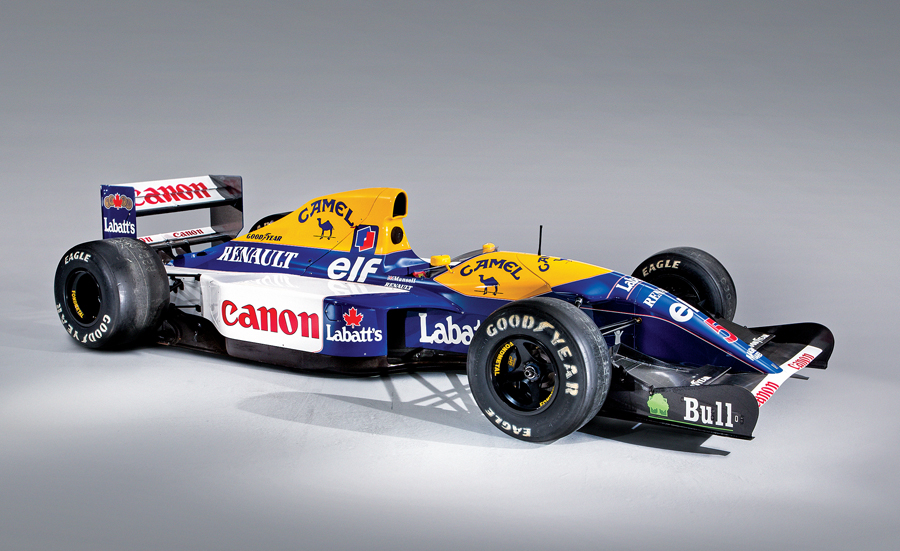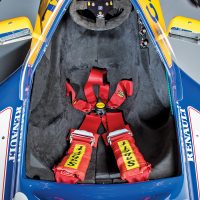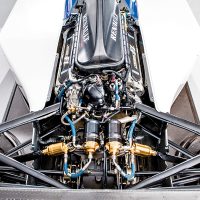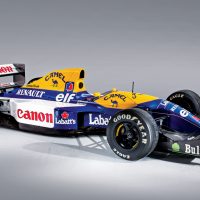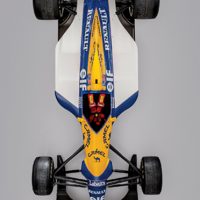SCM Analysis
Detailing
| Vehicle: | 1992 Williams-Renault FW14B Formula One |
| Years Produced: | 1992 |
| Number Produced: | Six |
| Original List Price: | N/A |
| SCM Valuation: | $1.9 million |
| Chassis Number Location: | Side of driver’s compartment |
| Engine Number Location: | Unknown |
| Club Info: | Williams Heritage |
| Website: | http://www.williamsf1.com/heritage |
| Alternatives: | 1992 Ferrari F92A, 1992 Benetton B192, 1992 Ligier-Renault RS3B |
| Investment Grade: | A |
This car, Lot 345, sold for $3,392,949, including buyer’s premium, at Bonhams’ Goodwood Festival of Speed sale on July 5, 2019.
The Williams-Renault FW14B of 1992 and its successor, the 1993 FW15C, are arguably the most complex, technologically sophisticated Formula One cars of the 20th century.
After humble beginnings, Frank Williams’ team blossomed in the late ’70s. He quickly developed an organization that defined the elite of the era, winning nine Constructor’s Championships between 1980 and 1997.
He did this by assembling a group of designers, engineers and technicians who relentlessly pushed the limits of whatever technology constituted the current “unfair advantage.”
This team created cars that somehow transcended the state of the art as defined by the competition. Interestingly, Williams came up with few real innovations — that seemed to be Lotus’ specialty — but once they arrived, Williams incorporated and optimized them to create winning racers.
The impact of ground effects
Williams’ technical prowess really emerged in the era of what we call ground-effects cars. Lotus had pioneered the concept of using expanding volume tunnels under a car to create vacuum — and thus downforce — as the speed increased, but Williams came up with their FW07 that simply did the job so much better that it dominated the competition.
The whole concept proved to be extremely dangerous because downforce was dependent on maintaining the vacuum in the tunnels, and drivers couldn’t know if they could go through a corner at 120 mph depending on tunnel downforce or at 90 mph without them working.
After a series of horrific crashes, ground effects were banned in 1983, replaced by the flat-bottom requirement that continues to the present.
The importance of downforce wasn’t diminished by the advent of flat bottoms — it simply moved to the top of the car. Engine development masked this for a while. The turbo era had dawned, and with 800 horsepower to well over 1,000 horsepower available, the power to drag huge wings around the track compensated for the loss of ground effects.
Welcome back, aerodynamics
That much power created its own problems, and the turbo era ended in 1989, when the engine rule changed to require 3.5-liter normally aspirated V8s and V10s. The consequent loss of power from roughly 1,100 hp to 650 hp required serious reconsideration of the aerodynamics of the cars. Subtlety became essential, and every piece of bodywork exposed to airflow had to be optimized for downforce at minimal drag.
At this point, control of the air under the now-flat bottom was essential, which meant controlling ride height and attitude was critical.
Enter computer-controlled suspensions
An obvious — if daunting — solution to this was to replace the springs and shocks with computer-controlled hydro-pneumatic cylinders at each corner and allowing an onboard computer to keep everything perfect. Both Lotus and Williams had been working on such a system since about 1987, but the complexity prevented it from going far.
By 1991, Williams was getting confident enough in the technology that they introduced the FW14, designed to accept either conventional or active suspension, and the 1992 FW14B actually did it.
It wasn’t just the suspension; microchip processors also controlled the engine (throttle and traction control) and the transmission, which was now semi-automatic (the driver could shift with a button, or the system would shift for him).
Complication layered on complication
Compared to what came before, or indeed after, the FW14B was an insanely complex machine, a forest of hydraulic lines, valves, pumps, relays, sensors and the like, all of which were controlled by microprocessors.
This, of course, brings us to the next problem: In 1992 the best chip available was the Intel 80486 running at 50 MHz. For comparison, that is roughly 1/3,000th of what we expect today. I am told that the operating software for the suspension used 1 megabyte of RAM.
That’s not much capacity to deal with a racer going 160 mph, so adjustments took a while as the chip thought about it. The system was reactive, which is to say that it kept things constant until something changed. The computer then figured out what to do and opened the appropriate valves, etc. to readjust.
Flinging the car into a corner apparently involved a few tenths of a second of “flightiness” while the suspension adapted, after which it stuck like glue.
Understandably, this could be disconcerting for a driver, but Nigel Mansell and teammate Riccardo Patrese learned to trust what it could do.
And, Lord, was it effective!
Domination
At Silverstone, Mansell qualified two seconds faster than Patrese, who was 0.8 seconds faster than Ayrton Senna in a McLaren. Mansell sealed the Championship in August with five races yet to be run, and Patrese took an easy second. The FW14B made the competition look like amateurs.
This created several problems. First, few if any of the other teams had the money or technical expertise to follow this path.
Second, it involved putting driver safety at the mercy of complex mechanisms that could — and did — fail.
Third, it was embarking upon a very scary science-fiction narrative where computers did everything and drivers were passengers at best.
All of these proved unacceptable and, after Prost in the FW15C successor car won 1993 in similar fashion, active suspension and most computer-controlled aids were outlawed. Another unfair advantage was eliminated, another era ended.
Formula One went back to being human controlled, but wow, were these spectacular diversions.
Important — but no longer usable
How does the market approach a car like this? It is clearly hugely important both historically and technically, but is not really usable.
Williams was extremely proud to state that they had it fully operational, and have the video to prove it, but only a fool would ever do more than a few laps at 8/10ths to be able to say they had.
The crucial suspension bits are 27 years old, it’s run by a system so antique (MS DOS 5.0) that most people don’t remember it, and the car is so valuable as a relic that risking it at racing speeds is unthinkable.
Clearly, having it operational is of value, but keeping it that way will be very expensive, as it requires continual maintenance.
In the end, this legendary race car has to be thought of as a purely collectible item — an investment.
Formula One cars, particularly important ones, have proven very desirable, and values have skyrocketed in the past 10 years or so. Alain Prost’s 1993 FW15C, non-running, sold for $410,000 in 2006.
I doubt that this trend will continue, but values are stable these days.
The purchaser is reputed to be one of the more astute automobile investors around, so very smart people think it was fairly bought.
I will have to concur. ♦
